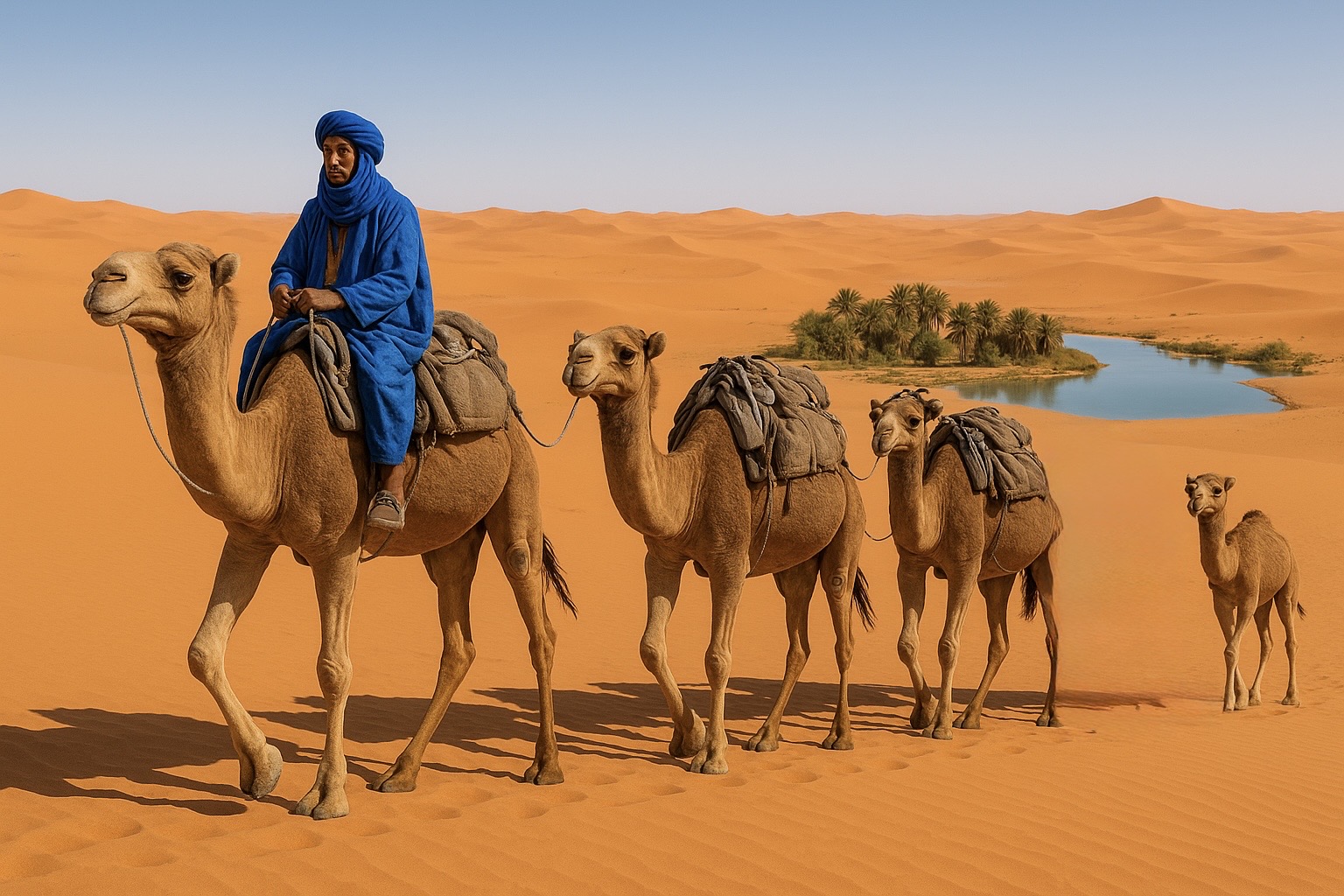
Dromedary Camels
Scientific name: Camelus dromedarius
Known as the dromedary camel, Arabian camel, or one-humped camel, storing up to 80 lbs (36 kg) of water bearing fat on its back. It is the tallest of the three Old World Camel Species.
Size: Adult males stand 5.9′-7.9′ Feet (1.8–2.4 m) at the shoulder, while females are 5.6′-6.3′ (1.7–1.9 m) at the shoulder.
From: Dromedaries are native to the arid regions of North Africa and The Middle East,
Dromedaries have also been introduced to Australia where feral populations are considered pests by the government. They also have been introduced to other parts of the world including The United States and Canada as Domestic Livestock .
Some evidence suggests domestication may have occurred in the Arabian Peninsula and Somalia; the earliest evidence for dromedary domestication dates back about 4,000 years ago on a small island off the Abu Dhabi coast.
Longevity: 40 to 50 years.
Stamina: A camels leisure walking speed is ~3 mph (~5 kph) and can cover 80 mi (128 km) to 120 mi (193 km) per day with a rider on its back keeping a steady speed of 15 mph (24 kph)for 8 hours daily; and in an emergency can reach a speed of 40 mph (64 kph).
water: A thirsty Dromedary can drink up to 50 gallons (189 liters)in one drink but typically drink 30 gal. (1113 lt.) to 35 gallons (132 liters) at a time.
Their fat hump stores fat which through a process of caloric metabolism is converted into water and energy.
camels have a specialized red blood cell (erythrocytes)that is oval and can absorb water expanding up to 240% compared to human red blood cells expanding 150% giving the camel the ability to stay hydrated more than twice as long.
Temperatures: Camels are the only worm blooded animal that can regulate their body temperature to deal with extreme ambient temperature fluctuations; their body temperature can vary from 68 F (20 C) to 77 F (25 C) at night and 100 F (38 C)to 114 F (46 C) in the day and never break a sweat!
Sexual Maturity: Males Rut (show sexual interest) at around 3 years and are sexually mature at 6 years while Females can breed as young as 3 years but it is recommended to wait until 4 years.
Gestation: 15 months (370 to 440 days) usually having 1 calf rarely 2 calves. Which will wean at about 12 to 24 months.
Breeding season: winter, or rainy season. believed to be cued nutritionally and by the length of days.
Family Order: A single male rules a family group and directs the family from the rear while the females take turns leading. the herd consists of a group of 2 to 20 individuals consisting of one male, and one to seven breeding females and subadult males and females, and young. The male within the family unit prevents stray males from mating females within the family by either standing or walking in between them, or by driving the stray males away. Stray Males will eventually allure 1 or 2 virgin females away from the herd and form a family unit of their own. Dromedaries tend to travel by walking single file.
Sexual Dimorphism: :Males are larger than Females and poses a Dulla (an inflatable sac formed by the soft palate)
During the breeding season, males extrude this “Dulla” from their mouths to attract females and assert dominance over other males. The dromedary male inflates the dulla with air and saliva, creating a gurgling sound, while it protrudes from his mouth. This display helps attract his females and also signals other males to stay away. When not in use he stores it in the throat.
Dromedary History:
Camels originate in North America: The Camel is not found in the fossil records of anywhere except North America.
fossil records indicate the Dromedaries ancestors paracamelus alexejevi migrated through the north East through Ellesmere island across frozen sea water and into Svalbard island then crossing what is now Barrents sea (but was dry land at that time) and dispersing into what is now Northern Europe and Russia eventually making it to the Arabian Peninsula and ultimately into Africa. While the ancestors of the Bactrians came across the bearing Streight into Siberia.
- Introduction to The United States: In the 1850s, the US Army Startedk The United States Camel Corps and imported dromedary camels, knowing they would be well-suited for traversing the desert terrain of the Southwest.
- Experiment:The camels were stationed in Camp Verde, Texas, and used for various tasks, including hauling supplies and participating in reconnaissance missions.
- Acquisition: They acquired 33 animals (19 females and 14 males), including two Bactrian, 29 dromedary, one dromedary calf, and one booghdee (a cross between a male Bactrian and a female dromedary).
one died in transit and two more born; after arrival 5 more died and 41 more were acquired leaving the Camel Corps with 70 Camels. - Capture: during the Civil War, the Confederate forces captured some of the camels which were later re-captured by the Northern forces.
- Dispersal: After the Civil War, the camels were largely released or sold, and some escaped into the wild.
- Feral Populations:These escaped or released camels formed feral populations that roamed the Southwest for several decades, with sightings reported into the Mid 1900s.
- Conservationists: During the early 1900s conservationists working for the Bureau of Land Management mis-understood their natural place in North America and had them rounded up and sold at public auction. it was later discovered by Anthropologists and Archeologists that the camel originated in North America and should be re-introduced.
- Last Reported Sightings: Although sightings persisted for several decades, the population of feral camels eventually dwindled and disappeared largely due to their High value they were captured and sold. The last documented and confirmed descendant of the original Camel Corps Camels, named Topsy, died in 1934.
- Last reported sighting: was in 1941 near Douglas, Texas.
- Domestic: Today it is assumed that all descendants of the Camel Corps Camels are owned by domestic parties across The United States.
- Anachronism: The Arabian camels in the Camel Corps readily ate creosote bush, which no other organisms eat. this meeting reestablished a biological relationship that was broken when the American ancestors and relatives of the Arabian camel, such as Camelops, became extinct, making an anachronism.
